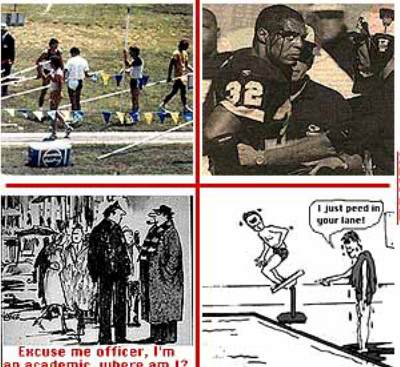Calming The Mind So The Body Can Perform
There’s two seconds left in the championship game, your team is behind by one point and you are at the free throw line shooting two shots. You’re keenly aware of the situation and you, like everyone else in the sold out arena, know how important these two shots are. You can feel your heart pounding and your legs are a little weak as you bounce the ball and prepare for your first shot. You take a last deep breath and push the ball towards the basket. You watch with considerable anxiety as the ball hits the front of the rim and bounces straight up. It comes back down and starts rolling around the rim, finally dropping through.
As the ball drops through the hoop you feel a tremendous sense of relief. It’s as if all the weight of the world has been lifted from your shoulders. The ball is passed to you by the referee for your second shot and you step up to the line and dribble the ball. This time,there is no thought of failure, there is no doubt in your mind. You know that you’re
going to make the shot. You take the last bounce, look to the basket, inhale, feel your knees bend slightly and begin pushing the ball towards the basket. It’s effortless and you’re in total control, you know before the ball leaves your hand that it’s going through without even touching the rim. You feel the excitement as watch the ball spin through
the air in slow motion towards it target. The moment almost seems frozen in time for you.
Just before your second shot, you entered what athletes refer to as “the zone.” One of the primary roles sport psychologists have, consists of trying to help athletes get into the zone and stay there. To do that, we have to help athletes quiet thought processes. We have to teach them to shut out distractions, to trust their bodies, to simply let themselves perform.
What is the Zone?
The zone is an altered state of consciousness. When you are in the zone, your normal way of experiencing things is dramatically altered. By examining the descriptions provided by elite level athletes, it’s possible to identify some of the common alterations of perception that occur when an athlete has a “peak experience”, or enters the “zone” or
“flow” state (Ludvig, 1966; Ravizza, 1977; Cohen, 1991; Williams & Krane, 1993). • There is a feeling of complete control, total confidence. • The athlete knows with certainty what is going to happen before it actually occurs.
• Time is slowed down.
• Objects seem larger and/or more vivid than usual.
• The performance is effortless, occurring automatically without any conscious
direction on the part of the athlete.
• There is a feeling of exhilaration even joy.
• The level of performance exceeds the individual’s expectations, making him or
her aware of a higher level of potential than he or she would have hoped for. From the descriptions provided by individuals who have had peak experiences and entered the zone, it’s obvious why it is such a desired state. Who among us would not like to feel totally confident and in control, to be able to perform as if in a dream? Unfortunately, athletes descriptions alone, don’t tell you how to get there.
Getting Into The Zone
There is considerable evidence supporting the theory that alterations in an individuals focus of concentration and/or changes in physiological arousal are what precipitate an altered state of consciousness. These changes may be brought about through meditation, hypnosis, the use of drugs, and/or biofeedback (Tart, 1969). To understand how these seeming diverse methodologies lead to similar experiences, you need to understand the role that focus of concentration plays in determining a person’s physical, mental (or cognitive), and emotional experience.
Robert M. Nideffer, Ph.D.
To read more,Please download the book.
Similar Videos and E-books
LEAVE A COMMENT
All Books
For Beginners
- Candlesticks For Support And Resistance
- Online Trading Courses
- Commodity Futures Trading for Beginners
- Hidden Divergence
- Peaks and Troughs
- Reverse Divergences And Momentum
- Strategy:10
- The NYSE Tick Index And Candlesticks
- Trend Determination
- The Original Turtle Trading Rules
- Introduction to Forex
- The Six Forces of Forex
- Study Book for Successful Foreign Exchange Dealing
- Forex. On-Line Manual for Successful Trading
- 18 Trading Champions Share Their Keys to Top Trading Profits
- The Way to Trade Forex
- The Truth About Fibonacci Trading
- Quick Guide to Forex Trading
- Chart Patterns and Technical Indicators
- Forex Trading
- Trading Forex: What Investors Need to Know
- My Dog Ate My Forex
- Point & Figure for Forex
Forex Market in General
- Screen Information, Trader Activity, and Bid-Ask Spreads in a Limit Order Market
- Strategic experimentation in a dealership market
- Limit Orders, Depth, and Volatility
- Reminiscences of a Stock Operator
- Market Profile Basics
- Quote Setting and Price Formation in an Order Driven Market
- Phantom of the Pits
- An Introduction to Market Profile and a Users Guide to Capital Flow Software
- The Effect of Tick Size on Volatility, Trader Behavior, and Market Quality
- Trading as a Business
- What Moves the Currency Market?
- Macroeconomic Implications of the Beliefs and Behavior of Foreign Exchange Traders
- All About the Foreign Exchange Market in the United States
Psychology of Trading
- A Course in Miracles
- Thoughts on Trading
- Calming The Mind So That Body Can Perform
- Lifestyles of the Rich and Pipped
- The Miracle of Discipline
- Zoom in on Personal Trading Behavior And Profit from It
- The Woodchuck and the Possum
- 25 Rules Of Forex Trading Discipline
- Stop Losses Are For Sissies
- Your Personality and Successful Trading
- Trading as a Business
- The 7 Deadly Sins of Forex (and How to Avoid Them)
- The 5 Steps to Becoming a Trader
Money Management
- Risk Control and Money Management
- Money Management
- Position-sizing Effects on Trader Performance: An experimental analysis
- Fine-Tuning Your Money Management System
- Money Management: Controlling Risk and Capturing Profits
- Money Management Strategies for Serious Traders
- The Truth About Money Management
- Money Management and Risk Management
Forex Strategy
- 1-2-3 System
- Bollinger Bandit Trading Strategy
- Value Area
- The Dynamic Breakout II Strategy
- Ghost Trader Trading Strategy
- King Keltner Trading Strategy
- Scalp Trading Methods
- LSS - An Introduction to the 3-Day Cycle Method
- Market Turns And Continuation Moves With The Tick Index
- The Money Manager Trading Strategy
- Picking Tops And Bottoms With The Tick Index
- The Super Combo Day Trading Strategy
- The Eleven Elliott Wave Patterns
- The Thermostat Trading Strategy
- Intraday trading with the TICK
- Traders Trick Entry
- Fibonacci Trader Journal
- Rapid Forex
- Microtrading the 1 Minute Chart
- BunnyGirl Forex Trading Strategy Rules and FAQ
- The Daily Fozzy Method
- Forex Traders Cheat Sheet
- Offset Trading
- How to Trade Both Trend and Range Markets by Single Strategy?
- A Practical Guide to Technical Indicators; Moving Averages
- FX Wizard
- FX Destroyer
- A Practical Guide to Swing Trading
- Practical Fibonacci Methods for Forex Trading
- Using The Heikin-Ashi Technique
- The Day Trade Forex System
- 5/13/62
- Not So Squeezy Trading Manual
- KobasFX Strategy
- Killer Patterns
- 3D Trading
- 4 Hour MACD Forex Strategy
- WRB Analysis Tutorial
Advanced Forex Trading
- A New Interpretation of Information Rate
- CCI Manual
- Nicktrader and Jeff Explaining Reverse and Regular Divers
- NickTrader on No Price CCI Divergence Trading
- Are Supply and Demand Driving Stock Prices?
- The Sharpe Ratio
- The Interaction Between the Frequency of Market Quotes, Spread and Volatility in Forex
- Trend Determination
- Trend vs. No Trend
- A Six-Part Study Guide to Market Profile
- How George Soros Knows What He Knows
- Core Point and Figure Chart Patterns
- Coders Guru Full Course
- Point and Figure Charting: a Computational Methodology and Trading Rule Performance in the S&P 500 Futures Market
- Evolving Chart Pattern Sensitive Neural Network Based Forex Trading Agents
- Heisenberg Uncertainty Principle and Economic Analogues of Basic Physical Quantities
- The String Prediction Models as an Invariants of Time Series in Forex Market
- Using Recurrent Neural Networks to Forecasting of Forex
- The New Elliott Wave Rule - Achieve Definitive Wave Counts












